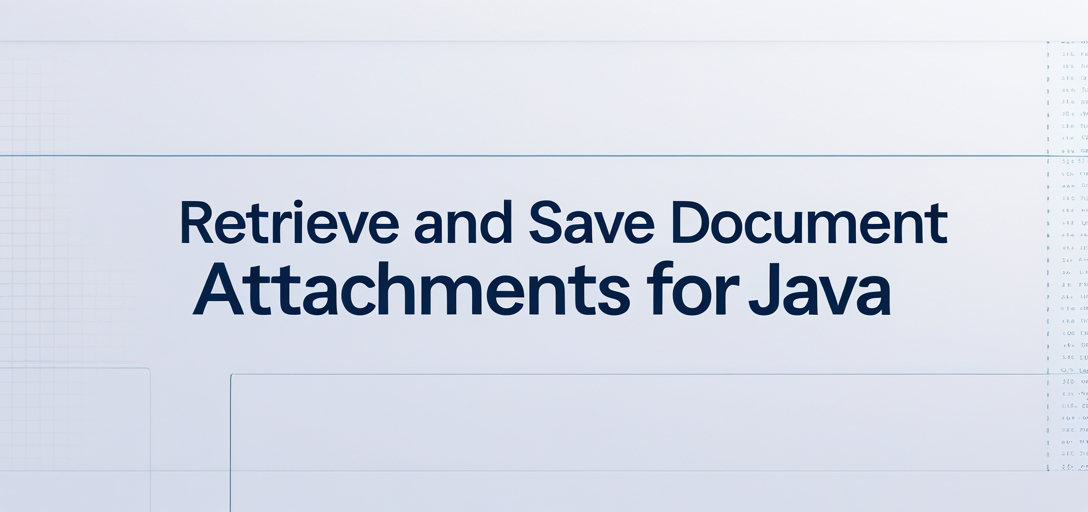How to Retrieve and Save Document Attachments Using GroupDocs.Viewer for Java: A Comprehensive Guide
Introduction
Are you looking to extract and manage document attachments programmatically in your Java applications? With the rise of digital document management, it’s crucial to have tools that streamline these processes efficiently. Enter GroupDocs.Viewer for Java—your go-to solution for seamlessly retrieving and saving document attachments with ease.

In this tutorial, we’ll explore how you can harness the power of GroupDocs.Viewer to retrieve attachments from documents and save them to your desired directory. By following along, you’ll gain practical skills in managing document data effectively within a Java environment.
What You’ll Learn:
- How to set up GroupDocs.Viewer for Java
- Retrieve attachments from a document using the API
- Save document attachments to a specified directory
Prerequisites
Before we begin, ensure you have the following:
- Required Libraries and Dependencies: You’ll need the GroupDocs.Viewer library. Make sure it’s added as a dependency in your project.
- Environment Setup Requirements: A Java development environment (like IntelliJ IDEA or Eclipse) to write and run your code.
- Knowledge Prerequisites: Familiarity with Java programming, especially handling files and directories.
With these prerequisites covered, we’re ready to set up GroupDocs.Viewer for Java!
Setting Up GroupDocs.Viewer for Java
To get started with using the GroupDocs.Viewer API in your project, you need to install it via Maven. Add the following configuration to your pom.xml file:
<repositories>
<repository>
<id>repository.groupdocs.com</id>
<name>GroupDocs Repository</name>
<url>https://releases.groupdocs.com/viewer/java/</url>
</repository>
</repositories>
<dependencies>
<dependency>
<groupId>com.groupdocs</groupId>
<artifactId>groupdocs-viewer</artifactId>
<version>25.2</version>
</dependency>
</dependencies>
License Acquisition Steps:
- Free Trial: Start with a free trial to explore the features.
- Temporary License: Obtain a temporary license for an extended evaluation period.
- Purchase: For production use, you’ll need to purchase a license.
Basic Initialization and Setup
Once GroupDocs.Viewer is added as a dependency in your project, initialize it in your Java application. Here’s how:
import com.groupdocs.viewer.Viewer;
import java.nio.file.Path;
public class InitializeViewer {
public static void main(String[] args) {
try (Viewer viewer = new Viewer("path/to/your/document")) {
// Your code to interact with the document goes here.
} catch (Exception e) {
e.printStackTrace();
}
}
}
This basic setup initializes the GroupDocs.Viewer and prepares it for retrieving attachments.
Implementation Guide
Retrieve Attachments from a Document
Let’s break down how you can retrieve attachments using GroupDocs.Viewer. This feature allows you to extract metadata about each attachment present in your document.
Overview
Retrieving attachments involves accessing the getAttachments method, which returns a list of Attachment objects containing details like file name and size.
Implementation Steps
Create a Viewer Instance Initialize the
Viewerclass with the path to your document:import com.groupdocs.viewer.Viewer; import com.groupdocs.viewer.examples.TestFiles; import com.groupdocs.viewer.results.Attachment; public class FeatureRetrieveAttachments { public static void main(String[] args) { try (Viewer viewer = new Viewer(TestFiles.SAMPLE_MSG_WITH_ATTACHMENTS)) { // Proceed to retrieve attachments } catch (Exception e) { throw new RuntimeException(e); } } }Retrieve Attachments Use the
getAttachmentsmethod:List<Attachment> attachments = viewer.getAttachments(); for (Attachment attachment : attachments) { System.out.println(attachment.getFileName()); }Understanding Parameters and Methods
Viewer: Takes a file path or stream to the document.getAttachments(): Retrieves a list of attached files, providing details like names.
Save Document Attachments to a Directory
Now that you’ve learned how to retrieve attachments, let’s save them to your desired directory using GroupDocs.Viewer API.
Overview
This feature involves saving each retrieved attachment file to a specified output directory.
Implementation Steps
Define the Output Directory Set up an
outputDirectorypath where files will be saved:import java.nio.file.Path; import java.nio.file.Paths; Path outputDirectory = Paths.get("YOUR_OUTPUT_DIRECTORY");Save Attachments Use a loop to save each attachment using the
saveAttachmentmethod:try (Viewer viewer = new Viewer(TestFiles.SAMPLE_MSG_WITH_ATTACHMENTS)) { List<Attachment> attachments = viewer.getAttachments(); for (Attachment attachment : attachments) { final Path file = outputDirectory.resolve(attachment.getFileName()); try (FileOutputStream outputStream = new FileOutputStream(file.toFile())) { viewer.saveAttachment(attachment, outputStream); } } } catch (Exception e) { throw new RuntimeException(e); }Explain Parameters and Methods
saveAttachment: Takes an Attachment object and a file output stream to save the attachment.FileOutputStream: Manages writing data to files.
Troubleshooting Tips
- Missing Dependencies: Ensure all Maven dependencies are correctly added.
- File Path Errors: Double-check paths for both documents and output directories.
- Access Permissions: Verify that your application has necessary permissions to read/write files.
Practical Applications
Using GroupDocs.Viewer in Java can be invaluable across various scenarios:
- Email Clients: Automatically extract attachments from email archives for processing or archiving purposes.
- Document Management Systems: Enhance document management by retrieving and organizing attached files.
- Legal Departments: Extract evidence-related attachments from legal documents securely.
Integration possibilities with other systems like CRM or ERP can further streamline business processes, making attachment handling seamless across departments.
Performance Considerations
To optimize performance when using GroupDocs.Viewer:
- Optimize File Handling: Use efficient file I/O operations and consider buffering for large files.
- Memory Management: Be mindful of memory usage, especially with large documents. Ensure proper resource cleanup to prevent leaks.
Adhering to best practices in Java memory management will significantly enhance the efficiency of your document handling tasks.
Conclusion
You’ve now explored how to retrieve and save document attachments using GroupDocs.Viewer for Java. This powerful API simplifies managing document data, making it an essential tool for developers working with digital documents.
To further explore GroupDocs.Viewer’s capabilities, consider experimenting with its other features or integrating them into your existing projects. If you have questions or need support, feel free to reach out through the provided resources.
FAQ Section
- How do I install GroupDocs.Viewer in my Java project?
- Use Maven dependencies as shown above for seamless integration.
- Can GroupDocs.Viewer handle all document types?
- It supports a wide range of formats; check their documentation for specifics.
- What if I encounter errors while saving attachments?
- Ensure file paths are correct, and you have the necessary permissions.